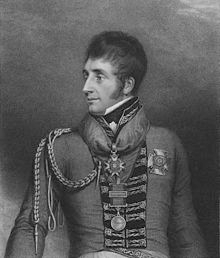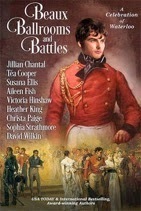Regency Personalities Series-Major-General Sir William Ponsonby
Regency Personalities Series
In my attempts to provide us with the details of the Regency, today I continue with one of the��many period notables.
Major-General Sir William Ponsonby
3 October 1772 ��� 18 June 1815

William Ponsonby
Major-General Sir William Ponsonby was the second son of William Ponsonby, 1st Baron Ponsonby of Imokilly and Hon. Louisa Molesworth. He married Hon. Georgiana FitzRoy, youngest daughter of Charles FitzRoy, 1st Baron Southampton. Between 1796 and 1798, Ponsonby sat as a Member of Parliament (MP) in the Irish House of Commons and represented Bandonbridge. Subsequently he stood for Fethard (County Tipperary) and held this seat until the Act of Union in 1801. He entered the British House of Commons in 1812, sitting for Londonderry until his death. In 1815, he was appointed a Knight Commander of the Order of the Bath (KCB).
When Ponsonby’s command, the 5th Dragoon Guards, arrived in the Peninsula in October 1811, it became part of John Le Marchant’s heavy cavalry brigade. For the rest of the war, this brigade included the 5th Dragoon Guards and the 3rd and 4th Dragoons. Ponsonby took part in Le Marchant’s famous charge at the Battle of Salamanca in July 1812. On that occasion, the British heavy dragoons rode down one French infantry division and part of a second before being repulsed. Upon Le Marchant’s death in the battle, Ponsonby took over the brigade, participating in the campaign that included the Siege of Burgos. In 1813, Ponsonby led his 1,200-strong cavalry brigade at the Battle of Vitoria. During the Battle of the Pyrenees and the fall campaigns in the mountains, the Duke of Wellington sent the bulk of his cavalry to the rear. On 25 January 1814, Ponsonby took leave of his brigade and in the final battles in France, Lord Charles Manners exercised command.
Ponsonby’s part in the Battle of Waterloo has been remembered because it highlights some pertinent points about cavalry charging. Ponsonby was in command of the Union Brigade, so-called because it included an English, a Scottish and an Irish regiment. The brigade consisted of the 1st Royal and 6th Inniskilling Regiments of Dragoons in the first line and the 2nd Royal North British Dragoons (Scots Greys) in reserve. It had counter-attacked to great effect against the disorganised French columns of Drouet D’Erlon’s I Corps. Carried away by their initial success, however, the brigade failed to rally and continued towards the French positions.
The Scots Greys in particular, forgetting their supporting role and ignoring the ���recall���, charged on in disordered groups, some of whom reached the French guns on the other side of the valley. By this time their horses were blown and a swift retribution followed in the shape of a counter-attack by the French Lancers. The brigade suffered very heavy losses, being effectively destroyed, and it played no further part in the battle. Ponsonby, who was mounted on a horse of less value than the best one in his stable, rode too far and with his horse mired in mud near to enemy lines was set upon by French Lancers. Recognising his rank and worth as a prisoner the French beckoned on him to surrender, but he didn’t understand them. Then when a group of his own Union Brigade spotted him and rode to his rescue, the Lancers from one of the French line regiments (either the 3rd Lancers or 4th Lancers) attached to d’Erlon’s I Corps were left with no option but to kill him. Myths growing up after the battle turned this into a guardsman from the “Red Lancers”, which included the surviving squadron of Polish lancers.
And Coming on April 1st, 2015
Beaux Ballrooms and Battles anthology, celebrating the 200th anniversary of the victory at Waterloo in story.

Looks good, huh? The talented writer and digital artist, Aileen Fish created this.
It will be available digitally for $.99 and then after a short period of time sell for the regular price of $4.99
The Trade Paperback version will sell for $12.99

My story in the anthology is entitled: Not a Close Run Thing at All, which of course is a play on the famous misquote attributed to Arthur Wellesley, ���a damn close-run thing��� which really was ���It has been a damned nice thing ��� the nearest run thing you ever saw in your life.���
Samantha, Lady Worcester had thought love was over for her, much like the war should have been. The Bastille had fallen shortly after she had been born. Her entire life the French and their Revolution had affected her and all whom she knew. Even to having determined who she married, though her husband now had been dead and buried these eight years.
Yet now Robert Barnes, a major-general in command of one of Wellington���s brigades, had appeared before her, years since he had been forgotten and dismissed. The man she had once loved, but because he had only been a captain with no fortune, her father had shown him the door.
With a battle at hand, she could not let down the defenses that surrounded her heart. Could she?
As her father���s hostess, she had travelled with him to Brussels where he served with the British delegation. Duty had taken her that night to the Duchess of Richmond���s ball. The last man she ever expected to see was Robert, who as a young captain of few prospects, had offered for her, only to be turned out by her father so that she could make an alliance with a much older, and better positioned (wealthy), aristocrat.Now, their forces were sure to engage Napoleon and the resurgent Grande Arm��e. Meeting Robert again just before he was to be pulled into such a horrific maelstrom surely was Fate���s cruelest trick ever. A fate her heart could not possibly withstand.




